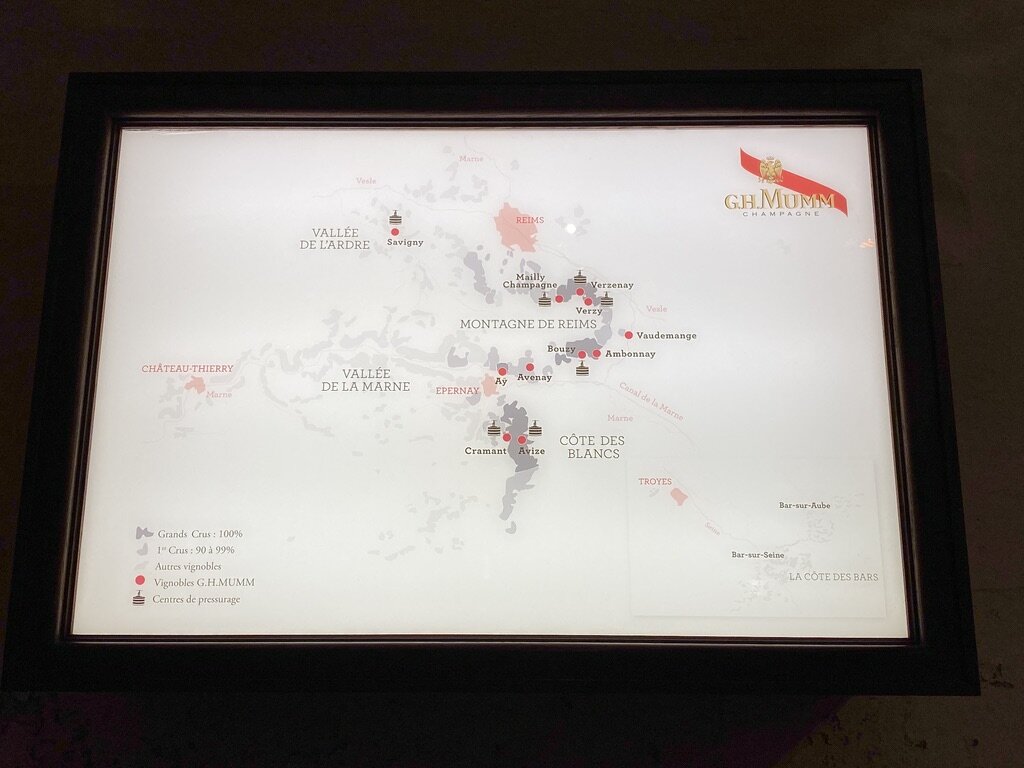The Champagne Region
In Champagne there are 84,000 acres that consist of 319 villages or crus. The 16,100 growers provide grapes for their own production or to the 140 co-ops and 360 houses in the region. There are five main growing areas: Montagne de Reims, Vallée de la Marne , Côte des Blancs, Côte de Sézanne and Côte des Bar. These regions can be further divided into 17 terroirs. There are 17 Grand Crus and 42 Premier Crus throughout the Champagne region.
The Montagne & Val de Reims
Consists of four very different terroirs with the distribution of 40% Pinot Noir, 34% Meunier and 26% Chardonnay.
Massif de Saint-Thierry is the northernmost section of Champagne and is located on the right bank of the Vesle river. The majority of the vines face southeast and are planted to Meunier 54%, Pinot Noir 29% and Chardonnay 17%. The soils are sand, marl and clay. The Meunier is structured and mineral compared the the wines of the Vallée de la Marne.
Vesle and Ardre Valleys (Val de Reims) is west of Reims and South of Massif de Saint-Thierry the vines run along both the Ardre and Vesle rivers with sand, marl and clay soils. There are 12 premier crus and plantings consist of Meunier 61%, Pinot Noir 25% and Chardonnay. The Meunier is structured and mineral.
Monts de Berru - East of the Montagne de Reims with chalk sub soils that are planted with 91% Chardonnay.
Grande Montagne de Reims is horse-shoe shaped and the slopes face south, southeast, northeast, and north. Soils depend on the location of the village and consist of chalk (30% Chardonnay) and limestone rich marl where Pinot Noir is planted (56%). There are 9 Grand Crus: Ambonnay, Bouzy, Louvois, Beaumont-ser-Vesle, Verzenay, Verzy, Mailly, Sillery, and Puisieulx. The two villages known for Chardonnay Villers-Marmery and Trépail create a waxy wine and the later a mineral driven wine.
Vallée de la Marne
Vallée de la Marne is west of Epernay and the Marne river runs through it. It is predominantly sand, marls and clay and is planted to 60% Meunier. The right bank (north side) faces south and the left bank (south side) faces north.
Grande Vallée de la Marne is located between the Grande Montagne de Reims and Epernay. The majority is planted with Pinot Noir (64%) followed by Chardonnay (20%) and Meunier (15%). There are two Grand Cru villages: Tours-sur-Marne and Ay. The champagnes have a warm profile.
Coteaux Sud d’Epernay is just south of Epernay and in between the Côte des Blancs and Vallée de la Marne. The soils are chalk by the Côte des Blancs and then become sand, marls and clay as you move west. Chardonnay is grown on the chalk soils (42%) and Meunier (45%) on sand, marls and clay.
Vallée de la Marne Rive Gauche (left bank) sand, marl and clay soils planted to 76% Meunier with a high acidity due to being unable to completely ripen.
Vallée de la Marne Rive Droite (right bank) sand, marl and clay soils planted to 70% Meunier which is ripe and rich due to the south facing vines.
Condé is a limestone uplift in the Aisne that is planted with 69% Meunier creating an earthy champagne.
Vallée de la Marne Rive Ouest is the western most section of Champagne and the vines are planted on the right bank and face south and southeast. The soils are sand, marls and clay with 69% Meunier and creates an earthy champagne.
Côte des Blancs, Côte de Sezanne, Vitryat and Montgeux
This area as known as dry champagne due to the chalk subsoils and is planted with 84.5% Chardonnay.
The Côte des Blancs is a hill that runs 8 miles from northeast to southwest. The chalk subsoils are home to Chardonnay (97%) the remaining Pinot Noir is planted in Vertus which is the Southern part of the region. There are 6 Grand Cru villages: Avize, Chouilly, Cramant, Oiry, Oger and Le Mesnil-sur-Oger. Chouilly, Cramant and Avize create richer and fuller champagnes whereas Le-Mesil, Oger and Vertus create linear and racy champagnes. Chouilly creates creamy Chardonnay that can round out a blend. Cuis produces acidic wines of structure and strength. Avize produces wines that are either mineral and full of finesse or rich and complex. Oger adds chalkiness and flowery fruitiness whereas Le Mesnil-sur-Oger has an intense salinity. If clay is present the wine becomes earthier and flinty.
Val du Petit Morin is Southwest of the Côte des Blancs and the river runs west into the Marne. The soils are chalk, sand, marl and clay and planted 52% to Chardonnay and 38% to Meunier. There are four Chardonnay premier cru villages: Etrechy, Val-des-Marais, Villeneuve-Renneville and Voipreux lying both east and west of the Côte des Blancs.
Vitryat (Vitry-le-François) is southeast of the Côte des Blanc and consists of chalk subsoils planted 98% to Chardonnay.
Montgeux is to the west of Troyes and the vineyards face south. The chalk subsoils are planted 90% to Chardonnay and 10% to Pinot Noir. The champagnes have tropical notes of mango and pineapple.
The Côte des Bar
The Côte des Bar is the southernmost part of the Champagne Viticole and the soils are limestone rich Kimmeridgean marl (fossilized sea urchin). The area is planted primarily to Pinot Noir and is considered Wet Champagne. The champagne is full-bodied, rich and ripe.
Bar-sur-Aubois - The Aube river runs through this area that is planted 80% to Pinot Noir.
Barséquanais consists of five river valleys including the Seine and is planted with 86% Pinot Noir.





